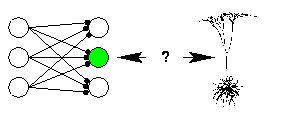General
Projects
Pattern Recognition in Pyramidal Cells
As a progression from my work on the associative net, I am now considering the computational properties of pyramidal cells as compared to the computing units in the network model.
Pattern Recognition [top]
A computing unit in an associative net can be regarded as a pattern recognition device. As its connections with input units are modified by Hebbian learning it comes to recognise particular patterns of activity on the input units (those patterns with which it was cooactive during learning). Taken in isolation, the ability of a unit to recognise particular patterns can be gauged by measuring the signal-to-noise ratio of the weighted sum of the inputs to the unit from patterns that should be recognised compared to patterns that should not. A comparison of the pattern recognition capabilities of a computing unit and a model of a neocortical pyramidal cell has been carried out (Graham and Willshaw, 1997). The pyramidal cell was simulated using a detailed compartmental model. The same set of input patterns was associated with the unit and the cell by Hebbian learning. Spatio-temporal noise in the pyramidal cell led to a lower signal-to-noise ratio in the pyramidal cell.
The above study considered input patterns to be coded by spike trains of constant frequency on the active input lines. A new study has considered the perhaps more realistic scenario of active inputs being represented by a single presynaptic action potential. The postsynaptic cell was modelled as a CA1 pyramidal cell. In this situation the signal-to-noise ratio is still lower than that of a computing unit, but active dendritic processes or scaling of synaptic conductances can result in very respectable performance for the pyramidal cell (Graham, 1999, 2001).
Spatio-temporal Noise in Pyramidal Cells [top]
In the computing unit, all inputs arrive at the same time and are summed perfectly. In the pyramidal cell, signals arrive at different times and travel different distances along the dendrites to reach the final point of summation in the cell body. This leads to spatio-temporal noise that degrades the weighted sum of the inputs and hence the achievable signal-to-noise ratio. Our simulations show a one to two order of magnitude drop in the signal-to-noise ratio due to this noise when the dendrites of the neuron are passive conductors.
If the input patterns are represented by trains of action potentials,
the signal-to-noise ratio depends on their frequency. An
optimum input firing frequency can be found that suits the dynamics of
the synapses and the dendrites.
References [top]
Graham, B. (2001). Pattern recognition in a compartmental model of a CA1 pyramidal neuron. Network, 12:473-492. (online).
Graham, B. (1999) The effects of intrinsic noise on pattern recognition in a model pyramidal cell. In ICANN 99, 1006-1011. IEE Conference Publication No.470 (manuscript).
Graham, B. and Willshaw, D. (1997) A model of clipped Hebbian learning in a neocortical pyramidal cell. In Gerstner, W., Germond, A., Hasler, M. and Nicoud, J-D. (eds), Artificial Neural Networks - ICANN '97, 151-156. Springer, Berlin. (manuscript; poster).
